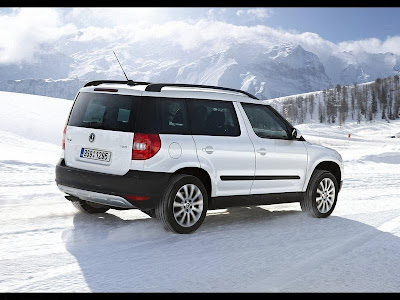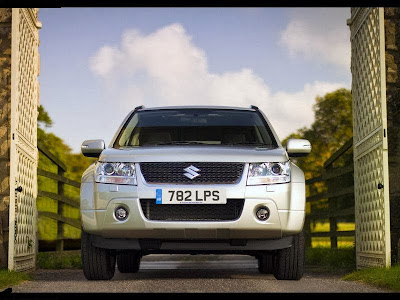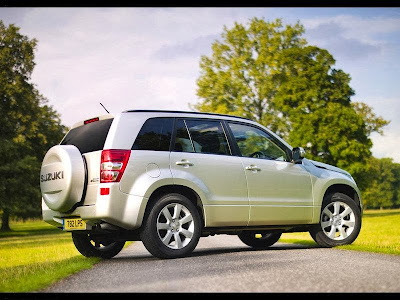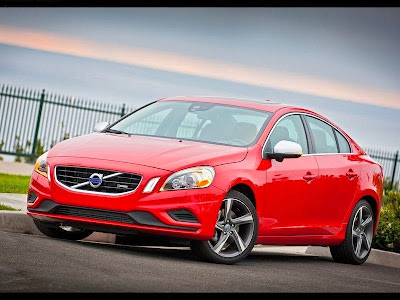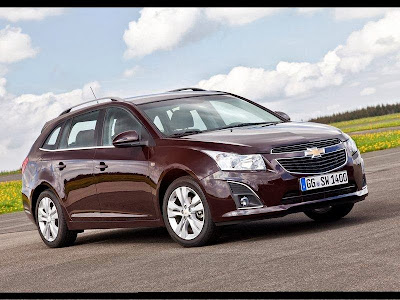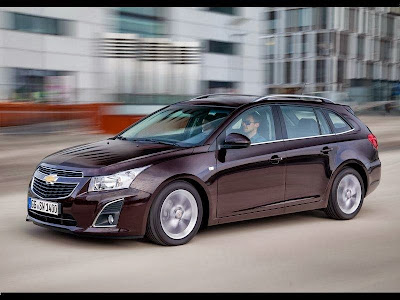Skoda Yeti 4x4 model year 2011
People have never tired of talking about that mythical creature who, with his white fur coat and sharp teeth, lives high up in icy mountains. Although they have never met him, people still speak with great conviction of their encounter with that peaceful inhabitant of the dizzying heights, who is said to have shown many a lost soul the route from the regions of eternal ice to the safety of the valley below. Škoda Auto is celebrating a new member of our model range, which has been given the name of that helpful snowman: The Škoda Yeti is launched. The choice of name truly has a deeper significance. The Škoda Yeti is strong, geared to move under difficult conditions and help its passengers along where others give up. But it has the edge on the original Yeti: Unlike him, it is also happy in warmer areas, finding its way not just in difficult terrain and off road, but with equal confidence and assurance on the road.
These were precisely the aims its designers had in mind during Škoda Yeti's development: The fifth model in the Škoda range would combine these virtues, which have so far been realised by cars in completely different segments, but not found together in one vehicle. That is, the handling and driving comfort of conventional mid-range vehicles, combined with brilliant off-road capabilities. That such a vehicle should also provide above-average space, high carrying capacity and a powerful towing capability has raised the stakes considerably
These were precisely the aims its designers had in mind during Škoda Yeti's development: The fifth model in the Škoda range would combine these virtues, which have so far been realised by cars in completely different segments, but not found together in one vehicle. That is, the handling and driving comfort of conventional mid-range vehicles, combined with brilliant off-road capabilities. That such a vehicle should also provide above-average space, high carrying capacity and a powerful towing capability has raised the stakes considerably
The result marks a new chapter in the extremely diverse history of Škoda. Although in the past there were a number of off-road vehicles in the long-established Škoda brand, they never even remotely met the high demands of uncompromised suitability for driving on normal, public roads as well as off-road that Škoda Yeti does.
The first notable Škoda off-roader was a prototype of the Škoda Superb 3000 - Kfz 15 (type 956). From 1942 to 1943, it was built as a saloon with a 3.1 litre, in-line, six cylinder engine and four wheel drive. The type 973 off-road vehicle was produced from 1952 to 1956 and left its mark thanks to its off-road suitability, a wading depth of 600 millimetres, a climbing capability of 85 per cent and excellent handling on the road.
Yeti takes Škoda's experience of more than 100 years of car development, concentrating and honing it in a comfortable and powerful vehicle, setting new standards in the compact SUV segment. Škoda Yeti comes to market with five wide-opening doors, making access to the passenger compartment and luggage storing easy. In addition, permanent, intelligent, power-distributing four-wheel drive and ground clearance of 180 millimetres makes Škoda Yeti suitable for off-roading.
Škoda Yeti's overall length of 4,223 millimetres allows drivers to fit into even those parking spaces that are far from generous, while its width of 1,793 millimetres guarantees that the doors can be opened wide in tight spots. And if the terrain becomes rough and more challenging, the slim stature of the Škoda Yeti always finds a gap to get through. Dimensions are a height of 1,691 millimetres, unladen weight with driver of 1,520 kilograms (1.8 TSI 4x4) and a load of at least 545 kilograms, with flexible boot volume of 416 litres to 1,760 litres. A maximum trailer weight of 1,800 kilograms makes Škoda Yeti a safe and hardworking towing vehicle.
In the compact SUV segment, the Škoda Yeti encounters seasoned competitors, such as the Kia Sportage, the Hyundai Tucson, the Nissan Qashqai and Suzuki Grand Vitara. Škoda Yeti claims leadership in this very popular, but densely populated, class. Apart from its excellent off-road properties and handling characteristics in town, on country roads and motorways - which in no way lag behind those of the compact sector - the new Škoda possesses the youngest engine range in the segment. This ensures maximum fuel economy and the lowest possible emissions.
Škoda Yeti's developers believe the SUV class can only achieve lasting success with an environmentally sound and affordable engine strategy. Therefore, Škoda Yeti's engine range is based on Škoda's downsizing strategy, reducing capacity while at the same increasing performance, thanks to highly sophisticated forced induction. High torque at low engine speeds results from this innovative power unit development.
At the same time, consumption is lowered, easing the strain on Škoda Yeti drivers' wallets, and engine emissions drop, making a significant contribution to the reduction of CO2, NOX and HC. Škoda Yeti wants to be at home in nature and, therefore, not endanger it. For motorists who may not want permanent four-wheel drive, Škoda Auto also offers Yeti in front-wheel drive versions. The generous ground clearance of the new compact SUV still ensures better and safer progress on poor, rutted tracks
ŠKODA YETI SHOWS WHAT IT IS CAPABLE OF: THE DESIGN
Škoda Yeti wants to show what it is capable of. Its typical off-road design features mark it out as a self-confident and assured companion in everyday life as well as for special tasks. But the fifth Škoda model line nevertheless bears attributes typical of the brand and gives the new compact SUV a clear family identity, which was already apparent in the design study shown in 2005. Above all, this means the evocative rib-shaped grille with the distinct chrome surround and the Škoda logo centred above.
From the grille, feature lines run up the bonnet; loosening up the surface and finding their visual counterpart in the interior centre console. Large headlamps, fitted far up, provide Škoda Yeti with character, lending the front end a friendly look.
The side view is dominated by clear and serene lines, while the distinctly projecting wheel arches and wings confer on the compact SUV a unique character and the lower body protective panels are classic hallmarks of a vehicle with off-road capability. The black C pillars and roof rails as standard round off the robust shape.
The rear design is just as unfussy. The rear lights are C-shaped and the smooth, vertical tailgate opens easily and far upwards, so even tall drivers have no problems standing underneath it when it is raised. The tailgate window appears to wrap around the body encouraging the impression of a continuous window surface to the B pillar. This is a strong reminder of the visor optics that have become the key feature of the Škoda compact class. At the front and rear, underbody protection strips signal Škoda Yeti's off-road suitability, while front fog lamps enhance the front view.
The functional design of the 4,223 mm long and 1,793 mm wide body emanates lightness. Although the side view, with its prominent wings, 17" alloy wheels and 180 mm ground clearance give Škoda Yeti a robust look, it by no means appears cumbersome. The visual impression is confirmed by a look at the data. The minimum weight of the Škoda Yeti 1.8 TSI 4x4 with driver is 1,520 kilograms. The 103 kW (140 bhp) diesel-powered variant adds only 25 kg
Škoda Yeti wants to show what it is capable of. Its typical off-road design features mark it out as a self-confident and assured companion in everyday life as well as for special tasks. But the fifth Škoda model line nevertheless bears attributes typical of the brand and gives the new compact SUV a clear family identity, which was already apparent in the design study shown in 2005. Above all, this means the evocative rib-shaped grille with the distinct chrome surround and the Škoda logo centred above.
From the grille, feature lines run up the bonnet; loosening up the surface and finding their visual counterpart in the interior centre console. Large headlamps, fitted far up, provide Škoda Yeti with character, lending the front end a friendly look.
The side view is dominated by clear and serene lines, while the distinctly projecting wheel arches and wings confer on the compact SUV a unique character and the lower body protective panels are classic hallmarks of a vehicle with off-road capability. The black C pillars and roof rails as standard round off the robust shape.
The rear design is just as unfussy. The rear lights are C-shaped and the smooth, vertical tailgate opens easily and far upwards, so even tall drivers have no problems standing underneath it when it is raised. The tailgate window appears to wrap around the body encouraging the impression of a continuous window surface to the B pillar. This is a strong reminder of the visor optics that have become the key feature of the Škoda compact class. At the front and rear, underbody protection strips signal Škoda Yeti's off-road suitability, while front fog lamps enhance the front view.
The functional design of the 4,223 mm long and 1,793 mm wide body emanates lightness. Although the side view, with its prominent wings, 17" alloy wheels and 180 mm ground clearance give Škoda Yeti a robust look, it by no means appears cumbersome. The visual impression is confirmed by a look at the data. The minimum weight of the Škoda Yeti 1.8 TSI 4x4 with driver is 1,520 kilograms. The 103 kW (140 bhp) diesel-powered variant adds only 25 kg
HIGHLY SOPHISTICATED, FRUGAL AND POWERFUL. TWO PETROL ENGINES AND THREE DIESEL
Škoda Yeti's engine range includes five four-cylinder units with a performance spectrum from 77 kW to 125 kW (105 bhp to 170 bhp). It includes two petrol and three diesel units, which all meet the EU5 requirements.
The basic version is the 1.2 litre TSI petrol engine, which is used for the first time in a Škoda. This completely new power unit delivers 77 kW (105 PS) and provides its maximum torque of 175 Nm between 1,500 and 3,500 rpm. Customers can choose between the manual six-speed gearbox or the innovative seven-speed DSG.
The second petrol engine in the Škoda Yeti range is the muscular 1.8 TSI four cylinder with 118 kW (160 bhp). It reaches its torque peak of 250 Nm at very low engine speeds. The greatest pulling power is supplied between 1,500 and 4,500 rpm. Fuel consumption of this version, which is combined with permanent four-wheel drive, averages 8.0 litres per 100 kilometres (189 g/km CO2 emissions). This reduced consumption is due to measures such as a two-stage oil pump which, up to 3,500 rpm, works with a pressure of 1.8 bar and above that, if more oil is needed for lubrication, with 3.3 bar. An additional, second lambda sensor means improved exhaust quality, as the injection sequences and quantities can be controlled more precisely. Crankcase bearings, piston rings and further moveable engine components have been modified to reduce friction to optimum levels.
Also new for Škoda Yeti is the 2.0 TDI diesel range, available in three performance levels, all with direct common-rail injection and diesel particulate filter as standard. The basic version is the 81 kW (110 bhp) engine followed by 103 kW (140 bhp) unit. Maximum torque of 250 Nm and 320 Nm, respectively, is provided from 1,500 - 2,500 rpm and 1,750-2,500 rpm. Combined consumption for the 103 kW (140 bhp) version - with permanent four-wheel drive as standard - is 6.1 litres diesel per 100 kilometres, which means a CO2 emission of 159 g/km.
The top power unit of the diesel trio is the 125 kW (170 bhp) four cylinder with its burly torque of 350 Nm, reached between 1,750 and 2,500 rpm. Combined consumption over 100 kilometres is just 6.1 litres (159 g/km CO2). Exhaust gas recirculation, which - depending on revolutions and engine load - returns up to 60 per cent of the burnt mixture to the intake air, and a catalytic converter guarantee low exhaust gas values. On all four-wheel drive engine versions, the six-speed manual gearbox is supplied, with only the 2.0 TDI CR DPF/81 kW paired with a five-speed gearbox.
Petrol engines:
1.2 TSI 77 kW/105 bhp (front-wheel drive) - 6-speed manual gearbox / 7-speed DSG
1.8 TSI 118 kW/160 bhp (4x4) - 6-speed manual gearbox
Diesel engines
2.0 TDI CR DPF 81 kW/110 bhp (front-wheel drive) - 5-speed manual gearbox
2.0 TDI CR DPF 81 kW/110 bhp (4x4) - 6-speed manual gearbox
2.0 TDI CR DPF 103 kW/140 bhp (4x4) - 6-speed manual gearbox 2.0 TDI CR DPF
Škoda Yeti's engine range includes five four-cylinder units with a performance spectrum from 77 kW to 125 kW (105 bhp to 170 bhp). It includes two petrol and three diesel units, which all meet the EU5 requirements.
The basic version is the 1.2 litre TSI petrol engine, which is used for the first time in a Škoda. This completely new power unit delivers 77 kW (105 PS) and provides its maximum torque of 175 Nm between 1,500 and 3,500 rpm. Customers can choose between the manual six-speed gearbox or the innovative seven-speed DSG.
The second petrol engine in the Škoda Yeti range is the muscular 1.8 TSI four cylinder with 118 kW (160 bhp). It reaches its torque peak of 250 Nm at very low engine speeds. The greatest pulling power is supplied between 1,500 and 4,500 rpm. Fuel consumption of this version, which is combined with permanent four-wheel drive, averages 8.0 litres per 100 kilometres (189 g/km CO2 emissions). This reduced consumption is due to measures such as a two-stage oil pump which, up to 3,500 rpm, works with a pressure of 1.8 bar and above that, if more oil is needed for lubrication, with 3.3 bar. An additional, second lambda sensor means improved exhaust quality, as the injection sequences and quantities can be controlled more precisely. Crankcase bearings, piston rings and further moveable engine components have been modified to reduce friction to optimum levels.
Also new for Škoda Yeti is the 2.0 TDI diesel range, available in three performance levels, all with direct common-rail injection and diesel particulate filter as standard. The basic version is the 81 kW (110 bhp) engine followed by 103 kW (140 bhp) unit. Maximum torque of 250 Nm and 320 Nm, respectively, is provided from 1,500 - 2,500 rpm and 1,750-2,500 rpm. Combined consumption for the 103 kW (140 bhp) version - with permanent four-wheel drive as standard - is 6.1 litres diesel per 100 kilometres, which means a CO2 emission of 159 g/km.
The top power unit of the diesel trio is the 125 kW (170 bhp) four cylinder with its burly torque of 350 Nm, reached between 1,750 and 2,500 rpm. Combined consumption over 100 kilometres is just 6.1 litres (159 g/km CO2). Exhaust gas recirculation, which - depending on revolutions and engine load - returns up to 60 per cent of the burnt mixture to the intake air, and a catalytic converter guarantee low exhaust gas values. On all four-wheel drive engine versions, the six-speed manual gearbox is supplied, with only the 2.0 TDI CR DPF/81 kW paired with a five-speed gearbox.
Petrol engines:
1.2 TSI 77 kW/105 bhp (front-wheel drive) - 6-speed manual gearbox / 7-speed DSG
1.8 TSI 118 kW/160 bhp (4x4) - 6-speed manual gearbox
Diesel engines
2.0 TDI CR DPF 81 kW/110 bhp (front-wheel drive) - 5-speed manual gearbox
2.0 TDI CR DPF 81 kW/110 bhp (4x4) - 6-speed manual gearbox
2.0 TDI CR DPF 103 kW/140 bhp (4x4) - 6-speed manual gearbox 2.0 TDI CR DPF
125 kW/170 bhp (4x4) - 6-speed manual gearbox
Skoda Yeti 4x4 model year 2011
Skoda Yeti 4x4 model year 2011
Skoda Yeti 4x4 model year 2011 From the inside





